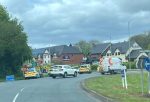KEEN-eyed nature lovers across Redditch, Studley and Alcester are being encouraged to report sightings of a recent arrival to the area.
Ivy bees, new to science in 1993, are only known from a few sites in the region but experts believe there must be more.
The first colony was discovered in Stourport on Severn in 2014 and two colonies were found in Worcester last year although the bees were also seen in Malvern, Bransford, Grimley, Evesham and Stourport.
Harry Green, trustee of Worcestershire Wildlife Trust and life-long naturalist, said: “Ivy bees were first discovered in the UK in 2001 and have been slowly spreading northwards as our climate is changing.
“Although they’re relatively new to Britain they don’t threaten our native bees; they start to fly rather late in the season so they’re not competing for the same food sources. In fact, their flight season is timed perfectly with the flowering of ivy so they’ll be on the wing from early September through to late October.”
The bees are relatively easy to identify – as large, or sometimes larger, than a honeybee. They have very defined bands across their abdomen, which have a distinct orange hue in fresh individuals, and orange hair on their thorax.
Although they’re a solitary bee – each individual collects food for their own young rather than for a colony – they nest in large aggregations. These aggregations can sometimes hold hundreds and occasionally thousands of bees.
The bees nest in a variety of locations from grassy slopes and cliffs to roadside verges and gardens. They prefer sparsely-vegetated south facing banks with loose (often sandy) soil.
Harry added: “If anyone notices a lot of bee activity in their garden, there’s no need to worry as they’re pretty harmless.
“The nests are remarkable – the female bees will usually burrow down to about 35cm before laying an egg and then heading off to find enough pollen to provision it with. The egg will hatch and eat the pollen, eventually becoming an adult bee and emerging next autumn.”
Worcestershire Wildlife Trust, in conjunction with Worcestershire Biological Records Centre, is encouraging anyone with a large stand of ivy near them to go and look for the bees throughout September and October.
Any sightings should be sent to the Worcestershire Biological Records Centre [email protected] along with date and location (grid reference and/or postcode) as well as a photograph to confirm identification.
Harry added “With an overall decline in bee numbers, it’s great to know that some species are bucking the trend and anyone who finds these in their garden is very lucky; we’d be delighted to hear of more ivy bees throughout the county.”
For more information about the work of the Trust and the Records Centre visit www.worcswildlifetrust.co.uk and www.wbrc.org.uk







